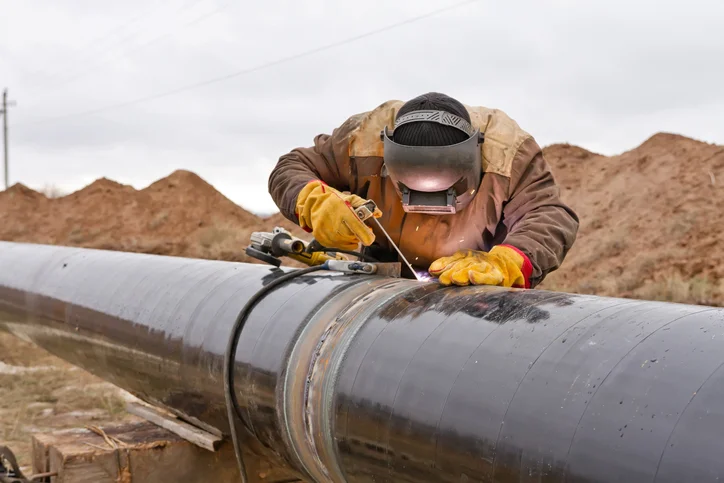Safeguard Your Financial Investment: Thorough Pipeline Welding Inspection for Comfort
Safeguard Your Financial Investment: Thorough Pipeline Welding Inspection for Comfort
Blog Article
Comprehensive Summary of Pipeline Welding Inspection Procedures
Pipeline welding examination treatments play a critical function in guaranteeing that bonded links meet strict market criteria and requirements. From thorough pre-welding assessments to extensive post-weld assessments, a distinct assessment procedure is important for keeping the structural soundness of pipes.
Pre-welding Inspection Preparations
Prior to beginning the welding procedure, complete pre-welding inspection prep work are vital to make sure the integrity and high quality of the weld joint. These prep work involve a meticulous exam of the materials to be bonded, the welding equipment, and the work setting. First of all, the products need to be checked for any defects, impurities, or disparities that can compromise the weld. This includes monitoring for correct product qualities, measurements, and surface area problems. Pipeline Welding Inspection. Additionally, the welding devices requires to be examined to confirm that it remains in excellent working condition, adjusted correctly, and appropriate for the certain welding procedure. Any kind of problems with the equipment should be dealt with without delay to stop problems in the weld. The job atmosphere need to be reviewed for sanitation, correct air flow, and safety measures to ensure a conducive setup for the welding procedure. By carrying out thorough pre-welding inspection prep work, possible problems can be determined and resolved at an early stage, leading to reputable and top notch weld joints.
Welding Treatment Credentials
Detailed pre-welding assessment preparations lay the foundation for the critical procedure of Welding Treatment Qualification, ensuring the integrity and top quality of the weld joint. Welding Procedure Credentials (WPQ) is an important action in the welding process that entails testing and accrediting welding treatments to guarantee they fulfill specific requirements and needs. The WPQ procedure commonly includes welding procedure requirements advancement, welding treatment certification screening, and documentation of the outcomes.
Throughout welding treatment specification advancement, essential details such as the welding procedure, welding products, joint layout, and welding parameters are defined to develop a comprehensive procedure. Consequently, welding treatment qualification screening is conducted to validate the suggested treatment's honesty. This screening commonly entails welding test discount coupons that go through different mechanical and non-destructive examinations to analyze the weld's quality and adherence to the specified requirements.
In-process Weld Assessment
Throughout the welding procedure, in-process weld assessment plays an important function in making sure the top quality and honesty of the weld joint - Pipeline Welding Inspection. This sort of assessment entails monitoring the welding criteria, analyzing the weld grain development, and finding any kind of possible flaws or stoppages as they take place. By performing in-process weld inspections, welding operators can quickly deal with any concerns that may emerge, consequently stopping additional flaws and making certain that the last weld satisfies the needed specifications
Typical methods utilized for in-process weld examination include visual assessment, fluid penetrant testing, magnetic particle testing, ultrasonic testing, and radiographic testing. On the whole, in-process weld inspection is important for maintaining the high quality and integrity of welded pipelines.
Non-destructive Screening (NDT)
Non-destructive Testing (NDT) is an important method employed in pipeline welding inspection to examine the honesty of weld joints without creating damage to the welded structure. By utilizing different NDT strategies, assessors can evaluate the quality of welds and identify any kind of problems or interruptions that might endanger the architectural soundness of the pipe. Common NDT methods used in pipeline welding evaluation include Radiographic Screening (RT), Ultrasonic Screening (UT), Magnetic Bit Checking (MPT), Fluid Penetrant Screening (LPT), and Visual Testing (VT)
RT includes using X-rays or gamma rays to create photos of the interior structure of the weld, permitting examiners to discover issues such as porosity, fractures, or insufficient blend. UT uses high-frequency acoustic waves to spot defects below the surface of the weld, supplying comprehensive information about the dimension and area of flaws. MPT and LPT are utilized to over here identify surface-breaking flaws by using magnetic bits or penetrant liquids to the weld area. Additionally, VT entails aesthetic assessment of welds to determine any visible imperfections.
Post-weld Assessment and Paperwork

Paperwork of post-weld inspection see this site searchings for is necessary for keeping quality assurance documents and guaranteeing conformity with industry criteria and policies. Thorough reports must include info concerning the inspection approaches used, the place and nature of any problems located, and any corrective activities taken - Pipeline Welding Inspection. Proper paperwork not just works as a document of the weld's top quality however additionally aids in future maintenance and inspection procedures
Conclusion

In verdict, pipe welding examination procedures play click for source an essential function in making sure the high quality and stability of welds. In general, adherence to proper inspection procedures is key to the success of pipeline welding projects.
From careful pre-welding examinations to thorough post-weld analyses, a distinct assessment procedure is necessary for preserving the architectural strength of pipelines. By conducting in-process weld inspections, welding operators can without delay resolve any kind of concerns that may occur, thereby preventing more issues and making certain that the last weld fulfills the needed specs.
Common approaches utilized for in-process weld inspection include visual examination, liquid penetrant testing, magnetic fragment testing, ultrasonic screening, and radiographic screening.Non-destructive Testing (NDT) is a crucial method used in pipeline welding inspection to evaluate the integrity of weld joints without triggering damages to the bonded structure. Post-weld examination includes various approaches to examine the welds for defects, consisting of visual evaluation, color penetrant testing, magnetic fragment testing, ultrasonic screening, and radiographic testing.
Report this page